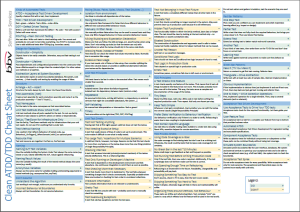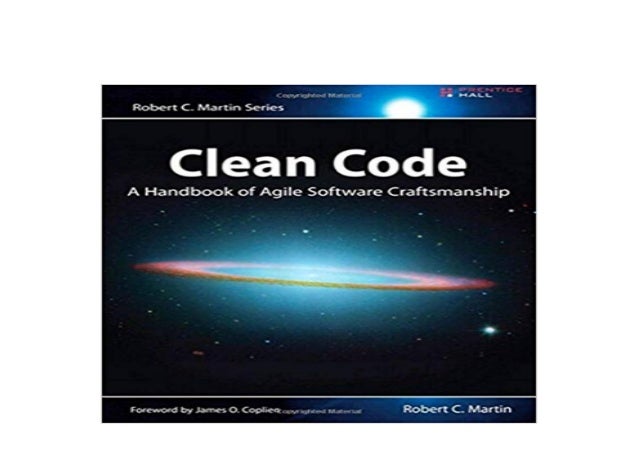As a general rule, comments are bad. In addition to cluttering the code, comments become useless as code changes because often the comments are not changed when the code is changed.
- Clean Code Pdf Github
- Robert Martin Clean Code
- Clean Code Pdf
- Clean Code Pdf Arabic
- Clean Code Pdf Uncle Bob
- Clean Code Pdf Free
- Clean Code Pdf Free
Writing clean code from the start in thinga project is an investment in keeping the cost of change as constant as possible throughout the lifecycle of a software product. Therefore, the initial cost of change is a bit higher when writing clean code (grey line) than quick and dirty programming (black line). WS Cleaning Code. 100% Trevira CS (polyester) is made with inherently flame retardant fibers. They can be cleaned with both water-based and solvent-based cleaning systems. Wool - S Cleaning Code. Wool fabrics as well as high-content wool fabrics (60% +) also carry S Cleaning Code, v acuum with a soft brush, wipe away. Writing clean, understandable, and maintainable code is a skill that is crucial for every developer to master. In this post, we will look at the most important principles to improve code quality and I will give you code examples for each of them. Most examples are taken from Robert J. Martin's Clean Code. It is a programming classic and I.
Usually if you find yourself needing to write a comment, it is because the code is not clear. There could be many reasons that the code is not clear, some of which were discussed in the previous posts about Robert C. Martin’s book, Clean Code. Try to train yourself to ask what you can do to clean up the code, before writing a comment, to eliminate its necessity.
Sometimes the solution is simply better naming. If your function names are clear with their intent, if the action that they will perform is stated in the function’s name, a comment about its operation is unnecessary. Similarly, if objects are named descriptively (ie: fileAgeInDays), there should be no question about what the object is that the name is describing.
Rarely comments are necessary, but they can be useful for things like adding legal headers or footers, or when the intent of a function is not obvious. It might be helpful to comment non-plain English parts of the code such as a regular expressions. They can also serve as a note for something to come back to if something needs attention that could not be met at the time of writing.
There is not much to say about comments except to try to avoid them whenever possible. Clarify through better naming and smaller methods rather than commenting.
Home > Store
Clean Code Pdf Github

Register your product to gain access to bonus material or receive a coupon.
- By Robert C. Martin
- Published Aug 1, 2008 by Pearson. Part of the Robert C. Martin Series series.
Best Value Purchase
Book + eBook Bundle
- Your Price: $53.99
- List Price: $89.98
- Includes EPUB, MOBI, and PDF
This eBook includes the following formats, accessible from your Account page after purchase:
EPUBThe open industry format known for its reflowable content and usability on supported mobile devices.
MOBIThe eBook format compatible with the Amazon Kindle and Amazon Kindle applications.
PDFThe popular standard, used most often with the free Adobe® Reader® software.
This eBook requires no passwords or activation to read. We customize your eBook by discreetly watermarking it with your name, making it uniquely yours.
More Purchase Options
Book
Robert Martin Clean Code
- Your Price: $39.99
- List Price: $49.99
- Usually ships in 24 hours.
eBook (Watermarked)
- Your Price: $31.99
- List Price: $39.99
- Includes EPUB, MOBI, and PDF
This eBook includes the following formats, accessible from your Account page after purchase:
EPUBThe open industry format known for its reflowable content and usability on supported mobile devices.
MOBIThe eBook format compatible with the Amazon Kindle and Amazon Kindle applications.
PDFThe popular standard, used most often with the free Adobe® Reader® software.
This eBook requires no passwords or activation to read. We customize your eBook by discreetly watermarking it with your name, making it uniquely yours.
Audiobook now available at your favorite audiobook retailer
Description
- Copyright 2009
- Dimensions: 7' x 9-1/4'
- Pages: 464
- Edition: 1st
- Book
- ISBN-10: 0-13-235088-2
- ISBN-13: 978-0-13-235088-4
Even bad code can function. But if code isn’t clean, it can bring a development organization to its knees. Every year, countless hours and significant resources are lost because of poorly written code. But it doesn’t have to be that way.
Noted software expert Robert C. Martin presents a revolutionary paradigm with Clean Code: A Handbook of Agile Software Craftsmanship. Martin has teamed up with his colleagues from Object Mentor to distill their best agile practice of cleaning code “on the fly” into a book that will instill within you the values of a software craftsman and make you a better programmer—but only if you work at it.
What kind of work will you be doing? You’ll be reading code—lots of code. And you will be challenged to think about what’s right about that code, and what’s wrong with it. More importantly, you will be challenged to reassess your professional values and your commitment to your craft.
Clean Code is divided into three parts. The first describes the principles, patterns, and practices of writing clean code. The second part consists of several case studies of increasing complexity. Each case study is an exercise in cleaning up code—of transforming a code base that has some problems into one that is sound and efficient. The third part is the payoff: a single chapter containing a list of heuristics and “smells” gathered while creating the case studies. The result is a knowledge base that describes the way we think when we write, read, and clean code.
Readers will come away from this book understanding
- How to tell the difference between good and bad code
- How to write good code and how to transform bad code into good code
- How to create good names, good functions, good objects, and good classes
- How to format code for maximum readability
- How to implement complete error handling without obscuring code logic
- How to unit test and practice test-driven development
Extras
Related Articles
Sample Content
Online Sample Chapters
Clean Code Pdf

Clean Code Pdf Arabic
Sample Pages
Table of Contents
Clean Code Pdf Uncle Bob

Foreword xix
Introduction xxv
On the Cover xxix
Chapter 1: Clean Code 1
There Will Be Code 2
Bad Code 3
The Total Cost of Owning a Mess 4
Schools of Thought 12
We Are Authors 13
The Boy Scout Rule 14
Prequel and Principles 15
Conclusion 15
Bibliography 15
Chapter 2: Meaningful Names 17
Introduction 17
Use Intention-Revealing Names 18
Avoid Disinformation 19
Make Meaningful Distinctions 20
Use Pronounceable Names 21
Use Searchable Names 22
Avoid Encodings 23
Avoid Mental Mapping 25
Class Names 25
Method Names 25
Don’t Be Cute 26
Pick One Word per Concept 26
Don’t Pun 26
Use Solution Domain Names 27
Use Problem Domain Names 27
Add Meaningful Context 27
Don’t Add Gratuitous Context 29
Final Words 30
Chapter 3: Functions 31
Small! 34
Do One Thing 35
One Level of Abstraction per Function 36
Switch Statements 37
Use Descriptive Names 39
Function Arguments 40
Have No Side Effects 44
Command Query Separation 45
Prefer Exceptions to Returning Error Codes 46
Don’t Repeat Yourself 48
Structured Programming 48
How Do You Write Functions Like This? 49
Conclusion 49
SetupTeardownIncluder 50
Bibliography 52
Chapter 4: Comments 53
Comments Do Not Make Up for Bad Code 55
Explain Yourself in Code 55
Good Comments 55
Bad Comments 59
Bibliography 74
Chapter 5: Formatting 75
The Purpose of Formatting 76
Vertical Formatting 76
Horizontal Formatting 85
Team Rules 90
Uncle Bob’s Formatting Rules 90
Chapter 6: Objects and Data Structures 93
Data Abstraction 93
Data/Object Anti-Symmetry 95
The Law of Demeter 97
Data Transfer Objects 100
Conclusion 101
Bibliography 101
Chapter 7: Error Handling 103
Use Exceptions Rather Than Return Codes 104
Write Your Try-Catch-Finally Statement First 105
Use Unchecked Exceptions 106
Provide Context with Exceptions 107
Define Exception Classes in Terms of a Caller’s Needs 107
Define the Normal Flow 109
Don’t Return Null 110
Don’t Pass Null 111
Conclusion 112
Bibliography 112
Chapter 8: Boundaries 113
Using Third-Party Code 114
Exploring and Learning Boundaries 116
Learning log4j 116
Learning Tests Are Better Than Free 118
Using Code That Does Not Yet Exist 118
Clean Boundaries 120
Bibliography 120
Chapter 9: Unit Tests 121
The Three Laws of TDD 122
Keeping Tests Clean 123
Clean Tests 124
One Assert per Test 130
F.I.R.S.T. 132
Conclusion 133
Bibliography 133
Chapter 10: Classes 135
Class Organization 136
Classes Should Be Small! 136
Organizing for Change 147
Bibliography 151
Chapter 11: Systems 153
How Would You Build a City? 154
Separate Constructing a System from Using It 154
Scaling Up 157
Java Proxies 161
Pure Java AOP Frameworks 163
AspectJ Aspects 166
Test Drive the System Architecture 166
Optimize Decision Making 167
Use Standards Wisely, When They Add Demonstrable Value 168
Systems Need Domain-Specific Languages 168
Conclusion 169
Bibliography 169
Chapter 12: Emergence 171
Getting Clean via Emergent Design 171
Simple Design Rule 1: Runs All the Tests 172
Simple Design Rules 2–4: Refactoring 172
No Duplication 173
Expressive 175
Minimal Classes and Methods 176
Conclusion 176
Bibliography 176
Chapter 13: Concurrency 177
Why Concurrency? 178
Challenges 180
Concurrency Defense Principles 180
Know Your Library 182
Know Your Execution Models 183
Beware Dependencies Between Synchronized Methods 185
Keep Synchronized Sections Small 185
Writing Correct Shut-Down Code Is Hard 186
Testing Threaded Code 186
Conclusion 190
Bibliography 191
Chapter 14: Successive Refinement 193
Args Implementation 194
Args: The Rough Draft 201
String Arguments 214
Conclusion 250
Chapter 15: JUnit Internals 251
The JUnit Framework 252
Conclusion 265
Chapter 16: Refactoring SerialDate 267
First, Make It Work 268
Then Make It Right 270
Conclusion 284
Bibliography 284
Chapter 17: Smells and Heuristics 285
Comments 286
Environment 287
Functions 288
General 288
Java 307
Names 309
Tests 313
Conclusion 314
Bibliography 315
Appendix A: Concurrency II 317
Client/Server Example 317
Possible Paths of Execution 321
Knowing Your Library 326
Dependencies Between Methods Can Break Concurrent Code 329
Increasing Throughput 333
Deadlock 335
Testing Multithreaded Code 339
Tool Support for Testing Thread-Based Code 342
Conclusion 342
Tutorial: Full Code Examples 343
Appendix B: org.jfree.date.SerialDate 349
Appendix C: Cross References of Heuristics 409
Epilogue 411
Index 413
More Information
- Request an Instructor or Media review copy.
Clean Code Pdf Free
Other Things You Might Like
Clean Code Pdf Free
- eBook (Watermarked) $38.39

- Book $47.99
- Book $27.99
